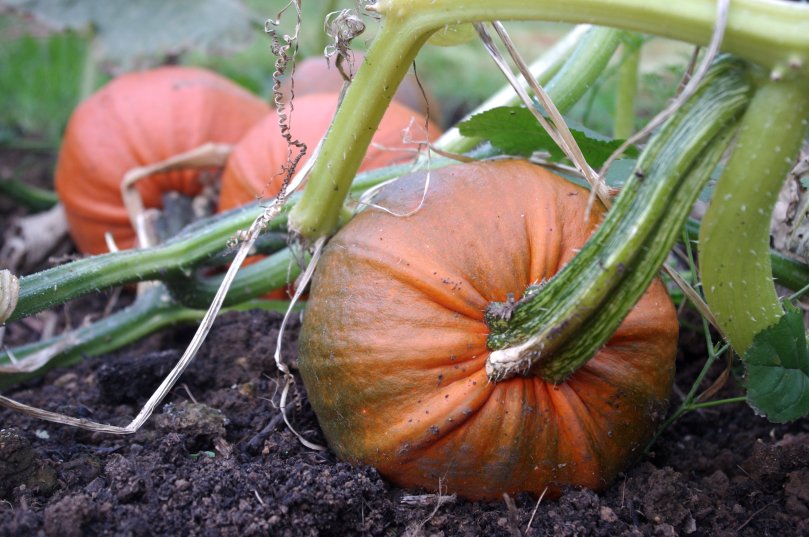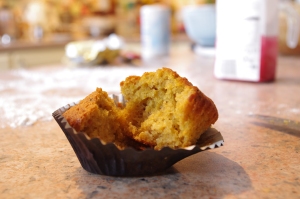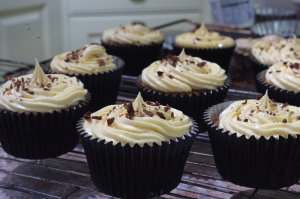I began a pumpkin patch in 2016, mainly because I love the look of big orange pumpkins in October. When I needed to pick them, I looked around for ways to turn them into food. Thankfully, pumpkins are very versatile, and can form the base of many delicious things; not just pie and soup.
This was last year’s crop:

There’s a few different ways of harvesting pumpkin flesh. Some recipes ask you to carve it out with a spoon. That’s all very well but you need arms like Wonder Woman to do it properly. I found it easier to peel the skin off first and then cut the flesh into chunks. Better yet was the oven method: halve the pumpkin, scoop out the middle, wrap it in foil, and bake in a medium-heat oven (140 fan) for an hour. Then you just scoop the flesh out, like ice-cream, and blend to make a puree which can be used in most recipes, and can be frozen for later. This method also makes the kitchen smell of cooked pumpkin – an earthy, exciting aroma – and wrapping something in foil and baking it will make you will feel as if you were cooking space food in the future.
The first thing I made was mini pumpkin pies. I decided to go miniature so that they were easier to share.
I added a meringue top, inspired by Tom Gilliford from 2016’s The Great British Bake-off. It’s much more traditional to serve pumpkin pie plain with a bit of whipped cream, but I love meringue more than I love whipped cream, and was curious to see if it would work. I’m not sure if putting meringue on top of pumpkin pie is considered heresy in America or not, but I do remember a friend’s mother making a pumpkin/cheesecake hybrid pie for Thanksgiving, and that seemed to be considered okay (and was delicious). Some countries have strict rules about what is considered correct – see Italians on pizza and Spaniards on paella – but I’m not sure the same applies to American cooking, which is often very creative.
One thing that killed me was not being able to put any cinnamon in the pies, but one of the people I was making the food for was allergic to cinnamon. As it was a choice between killing me (symbolically), and killing her (literally), I grudgingly decided to go for the former. I substituted cinnamon with a combination of cloves, ginger, allspice, and nutmeg.

I’m pretty happy with how these turned out, even though I did over-bake the meringue a touch (remember, it’s not burnt, it’s caramelised). Tom added orange curd to his pumpkin meringue recipe, which is an appealing idea; it would add a bit of pizzazz. Maybe next time.
Next on my list was pumpkin bread. Some recipes make a sweet bread, like gingerbread or banana loaf, but I wanted a savoury bread, so I used this recipe by Laura Scott. As Laura writes, this is a simple recipe because it requires no extra water, and good for a frugal cook, as pumpkins are relatively cheap.
Pumpkin bread is dense and chewy, and in the loafs I made, carried a strong flavour of rosemary and paprika. The pumpkin itself adds a little sweetness, and makes the bread turn a lovely beige. It goes very well with cheese or soup.
Speaking of soup:
The recipe called for chunks of uncooked pumpkin, rather than puree, but once the pumpkin is carved and added to the simmering water, you just have to leave it to dissolve. I added a stick of cinnamon, and garnished with paprika and coriander leaves. I also added some toasted pumpkin seeds, which I’d saved from my harvested pumpkins, boiled in salted water, and roasted with olive oil.
Two things not pictured: pumpkin brownies and pumpkin chips coated in salted egg. The pumpkin brownies were dry and tasteless, and I wouldn’t recommend making them. I’d had egg-coated pumpkin chips in China – in fact, it was the first time I’d ever eaten pumpkin – but I couldn’t manage to recreate it with just a frying pan; I think you need a deep fryer to do them properly.
The last thing I made was pumpkin cupcakes:
This I definitely recommend. Pumpkin batter makes a moist, airy sponge, a little like carrot cake. I topped mine with cream cheese frosting.










